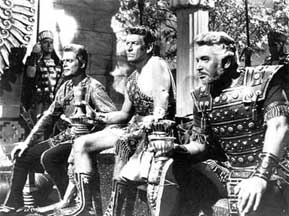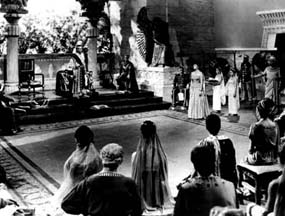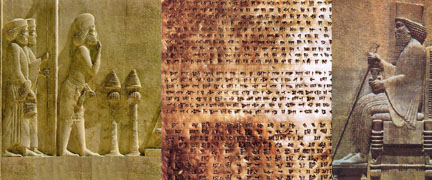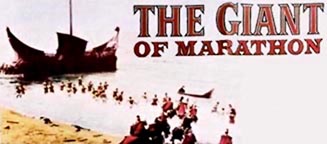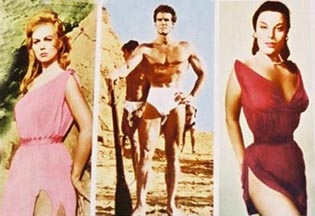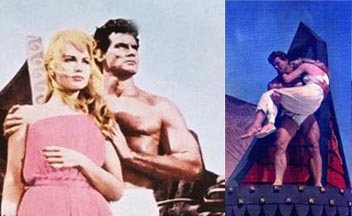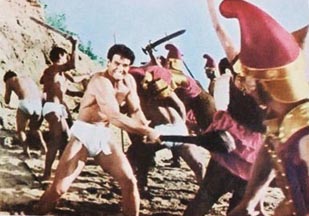The past is a foreign country, people do things differently there …
– L.P Hartley, The Go-Between
In the 1950's and 1960's the overgrowing popularity of television forced American cinema to make films only fit for the big screen. Often shot in Cinemascope and through co-production with European firms like the famous Cinnecita Studios in Rome, Hollywood was to focus attention on historical epics or stories inspired by the Bible. Some of these films made Hollywood history, like Cecile B. De Mille's 1956 remake The Ten Commandmants or William Wyler's 1959 remake Ben Hur which won 11 Oscars and both starred Charlton Heston — a record only equal1ed by James Cameron's 1998 epic, Titanic.
Never quite equalling the epic grandeur or acting qualities of De Mille or Wyler films, nevertheless the two films mentioned here became cult classics. The Swords-and-Sandals genre, also known as Péplum, often cast American along with Europeans stars. The heroes were thus portrayed by Americans such as Steve Reeves (Sylvester Stallone of his time) or Richard Egan, and the villains by non-Americans — often British actors distinguished by their accent.
Raoul Walsh's 1960 epic Esther and the King and French Hollywood expatriate Jacques Tourneur's The Giant of Marathon (1959) are two such films that deserve to be mentioned for they involve two historical events related to ancient Persia (also see: Persia?):
The first tells the story of the Persian Jewish queen, Esther, and the second, as its title implies, is about the military campaign against the Greeks led by the Persian emperor, Darius the Great and the defeat of his navy at the Battle of Marathon in 490 BC. It should be noted that Italian director Mario Bava (later known for his horror films) worked on both movies as assistant director as well as Daniella Rocca (as Queen Vashti, and Karis) and Sergio Fantoni (as Haman, and Teocrito) as supporting actors.
You will notice that movie posters of the time were very detailed in order to let the audience know what they were to expect : Violence, love and action. The characters were bigger than life, a way of distinguishing movie and TV stars.
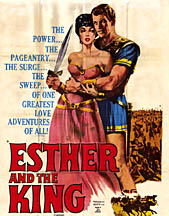
Esther and the King
(Larger image)
).
When Vashti (Daniella Rocca), the chief wife of Ahasuerus, displeases him, with a grotesque dance during a banquet, the king puts her aside and decides to choose a new wife from among the beauties of the kingdom. Just about to be married to her soldier fiance, back from the Egyptian wars with Ahasuerus, Esther a Jewish slave is carried off to be part of the beauty contest for Persia's new queen. Ahasuerus' choice falls on Esther.
Amidst the wars, pageantry, violence and mayhem, not to mention palace intrigues, the film is a touching story of Esther's growing love for the king of Persia and how she manages to stop the annihilation of her people by an intriguing courtisan Haman (Sergio Fantoni). Thus the story revolves around the struggle between Haman and Esther to influence the king.
Thanks to Esther's intercession and with the help of Mordecai (Denis O'Dea) the chief eunuch (actually according to the Bible her cousin and foster father) the Jews are able to defend themselves and destroy their enemies. Haman defeated, Mordecai becomes the king's new advisor for proving his loyalty and for having saved the king's life. Victory is celebrated and as the Persian king and Esther seal their love.
King Ahasuerus/Xerxes (Richard Egan), center, and his
ambitious courtisan Haman (Sergio Fantoni), left, in Esther and the King
Larger image
This film has the rare quality of being based on some historical research. The story is quite faithful to the Biblical account and even if Richard Egan appears Fair-haired and clean-shaven for a Persian monarch, the costumes and decors in this film are clearly faithful or at least inspired by to those of ancient Persia.
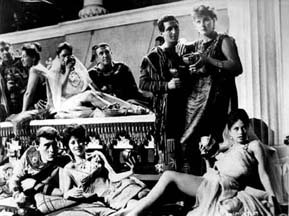
Amidst Lust at the palace of Susa
Larger image
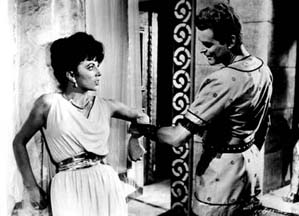
And intrigue at the Persian court …
Larger image
Esther (Joan Collins) tries to conquer
Persian King Xerxes' heart. Also below.
Larger image
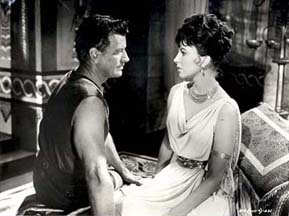
Larger image
As for Joan Collins, who earned stardom as a sex icon in an earlier swords-and-sandals film The Land of the Pharaohs directed by Howard Hawks, her beauty and innocence are simply captivating as her love for the king grows. She delivers one of her best performances. The rescue of the Jews by Esther is depicted in the Book of Esther in the Old Testament of the Bible and it is celebrated by Jews every year as the Feast of Purim.
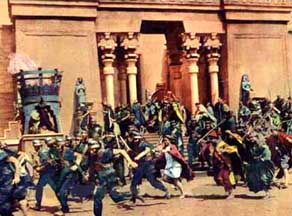
Intrigue to topple the kingdom
Larger image
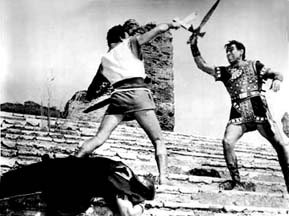
Xerxes sides with the Jewish cause
Larger image
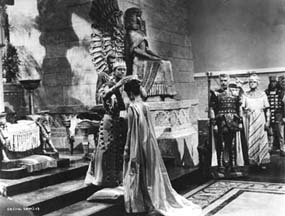
Esther is crowned Queen of Persia
Larger image
The period of the Greek history Between 492 – 479 BC is marked by the Persian Wars. It was a period of contest between the city-states of Greece and the mighty Persian Empire. The cause of the Persian Wars was the expansion policy of the Persians. It was impossible for latter to expand further east (to India), or beyond Egypt (due to the Libyan desert) or towards the inhospitable land of the Scythes (north). So their only choice was to advance west, to the European Continent. Greece was the primary barrier and Athens was the most decisive opponent in Greece.
The Persians needed only a pretext and Athens obligingly provided this in 500 BC when the Greek cities of Ionia in Asia Minor, forming part of the Persian Empire, revolted against Persian rule. Athens sent twenty ships to their assistance and the small city of Eretrtia in the island of Euboea sent five ships. The rebels had some initial success and burned Sardes, the capital of the Persian satrap of Ionia, but they were soon defeated by the Persians.
Bas relief Apadana Palace, Persepolis:
Reception (right) at the Court of Darius the Great (left), 521-486 BC
Commemorative decree in cueniform (center) of the King of Kings.
Larger image
King Darius, father of Ahasuerus (Xerxes 1st), upon learning that some obscure city-states from mainland Greece had sent help to the rebels, asked “What sort of thing is the city of Athens?” When briefed about those insolent Athenians, Darius became so angry that he fired an arrow skywards and vowed to punishment. His anger was such that every night at dinner, he had a servant repeat to him “Lord, don't forget the Athenians!“ In that way the Athenians gave the Great King the pretext he needed to invade Greece and clear the road to Europe.
To invade Greece, Darius had two routes: one by sea, one by land, each with advantages and disadvantages. He chose the sea route but it proved disastrous. His first expedition in 492 BC was led by his son-in-law Mardonius. He failed because of a storm which destroyed his fleet. Two years later in the Spring of 490 BC the Persian army and fleet reorganized, allowing the Persian King to launch his second attempt, again by sea but with a more southern route. This military expedition resulted in the Battle of Marathon.
Larger image
The Giant of Marathon (La Battaglia di Maratona) (1959) directed by Jacques Tourneur in 1959 is a US-Italian productio about Phillipides (Steve Reeves), an Athenian Olympic champion who is made captain of the Guards in Athens – but then is forced to rally the Spartans to fight the mighty Persian army led by Darius the Great (Daniele Vargas).
A triangle of love and hate:
Andromeda (Mylene Demongeot), Phillipides (Steve Reeves)
and Karis (Daniella Rocca ) are the stars of The Giant of Marathon
Larger image
This film teamed macho screen legend Steve Reeves with a fine director Jacques Tourneur and one of the best directors of photography in Italian history – Mario Bava. The combination makes for a beautifully-shot, colourful and well paced movie, which is a bit slow to start off but soon comes into its own with imaginative battle sequences and a story which is always moving.
A clean-shaven Reeves plays Phillipides, an Olympic legend who is a hit with all the ladies – and who finds himself torn between a forbidden beauty, Andromeda (Mylène Demongeot), and Karis (Daniella Rocca), a woman made to seduce him only to deliver him to his enemies.
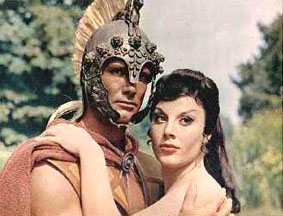
Phillipides (Steve Reeves) has to choose
between Karis' (Daniella Rocca) love and his duty.
Larger image
These romantic subplots are what make up the first half of the film, interspersed with plenty of dancing, a few fights here and there and lots of sweeping spectacles thanks to Bava, who really gives the film an expensive-looking veneer. The second half of the movie concerns the invasion by the Persians, with Phillipides attempting to rally the Spartans to his cause. There's an excellently-shot hand-to-hand combat scene involving an emissary who is attacked by a gang of cut-throats, who outnumber him 5-to-1 but still end up getting beaten.
Andromeda (Mylene Demongeot) captive of the
Persians is rescued by Phillipides (Steve Reeves).
Larger image
Then the film culminates in a fine sea battle in which Olympic heroes chuck burning spears at the approaching enemy ship, which retaliates by crushing their own ship with an awkward pair of pincers! At this point, there's also some great underwater photography and lots of violence as underwater attackers are shot and speared by the enemy.
Phillipides (Steve Reeves) singlehandedly
fights the Persians at Marathon
Larger image
Finally, a battle ensues — you can guess the outcome.
Historically Phillipides died in his titanic effort. But the marathon became one of the most popular Olympic competitions. The film prefers to drop this historic fact and chooses instead to match him with a sexy Greek girl Andromeda (Mylene Demongeot). Philippides appears thus as a Rambo-type character defeating the mighty Persian Army single handedly.
Reeves is as good as ever as the invincible masculine hero, and here he's supported by a strong cast which offers some good female characters. Tourneur's direction is assured and Bava's camerawork gives the film fine visual splendour which makes The Giant of Marathon a fine piece of solid entertainment especially for its action scenes.
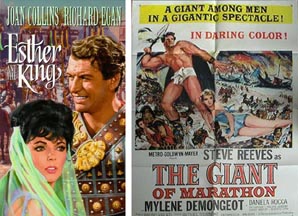
From Film to swords-and-sandals cult status
Larger image
In conclusion it could be said that although greatly romantized, Esther and the King and The Giant of Marathon offer entertaining glimpses into two major historical events that have contributed in shaping history.
Notes
Historical References
* The historical account of the Battle of Marathon in this article is based on the description by Herodutus.
* The can be visited in Hamadan, Iran.
* The Story of Esther is mentioned in The Book of Esther which is part of the Old Testament of the Bible .
* The books of Ezra, Nehemiah, Esther, Haggai, Zachariah, and Malachi were written during the time of the early Persian Kingdom. Ahasuerus, better known Xerxes, is not the only Persian King to be named in the Bible:
also remembered is Cyrus the Great as the liberator of the Jewish people after having freed them from captivity in Babylon. And King Darius The Great is mentioned in the story of .
Vocabulary
The term “swords-and-sandals” first appeared with films set in ancient times (Greece, Persia, Rome or Egypt ) and should be distinguished from swashbuckling films whose period is supposed to take place from the Middle Ages onwards (i.e: The Adventures of Robin Hood, Scaramouche ).
The term “epic“ however can be indifferently used in both cases above and is essentially used to describe any historical film involving large sets and a plot that requires showing big masses of people.
Remakes and Co-Productions
Cecile B. DeMilles The Ten Commandments and William Wyler's Ben Hur made in 1950's were actually remakes of the 1920's silent versions:
Early Hollywood Film productions were essentially shot in the United States, this was the case for De Milles first 1923 version of “The Ten Commandments” which was entirely shot in the Californian Desert where the sets of Ancient Egypt were reconstructed and ruins of which have been rediscovered today. I highly recommend you visit DeMille's Lost City website.
Ben Hur however was first adapted in 1927 by Fred Niblo with Ramon Navarro and was one of the first Hollywood films to be co-produced with European partners at the Cinnecita Studios in Rome. Hollywood had to wait until the end of WWII to reconsider co-productions with European studios in films like Joseph L. Mankiewicz Cleopatra shot at Cinnecita Rome, or Robert Rossen' 1956 epic Alexander the Great (see: Alexander the flop) shot in Spain.
This was cost effective for Hollywood thanks to cheaper labour and less union strikes. Today Hollywood and European Film companies have found a new haven in Morroco and Tunisia for major films requiring great reconstructions. Swords and Sandals“ Films like Ridley Scott's Gladiator, the lastest French epic parody Asterix & Obelix : Mission Cleopatra have all been shot in studios in Casablanca or Tunis.
Up Coming swords-and-sandals films set in or involving ancient Persia :
A number of Film projects and a TV series are currently being developed in Hollywood:
Alexander the Great to be directed by Baz Luhrman (Moulin Rouge, Romeo + Juliette) is to be released in 2004 with Leonardo Di Caprio. The film is expected to become the second-largest production of all-time, with 5,000 extras and a 150 million-dollar budget, including 50 million dollars for shooting in Morocco. Thousands of Jobs are to be created in the studio construction works in Morroco and shooting is set to start at the begining of February 2003.
Other projects on Alexander seem to inspire Hollywood directors. After Martin Scorsese who gave up, and has already cast Leonardo Di Caprio in his latest film “The Gangs of New York, Oliver Stone (Platoon, Wall Street, JFK) has been battling for the past five years on a film on the macedonian conqueror and wants to cast Irish with actors Collin Farrel, Heath Ledger, and Matthew McConaughey in what appears as a competition for the title role, and with Chris McQuarrie's script (The Usual Suspects) read review of .
Italian producer and huband to Sophia Loren, Dino De Laurentis, also wants to produce an Alexander film to be directed by Ridley Scott (Gladiator), has a very different casting approach. “I would like to have big stars in the secondary roles,” he says, “but I would get an unknown for the part of Alexander – a unique human being.”
Finally Mel Gibson is producing and directing a $200 million, 10-hour mini-series on “Alexander the Great” which is scheduled to start shooting in September in Morocco, Italy and Thailand. Gibson believes his 10-hour mini-series will have the edge over his feature-film rivals. “It's such a huge story,” he says. “You just can't tell the story of Alexander the Great in a couple of hours.”
The Gates of Fire, a remake of the 300 Spartans based on the novel of Steven Pressfield, is to be directed by Michael Mann (Heat, Ali) with George Clooney (Oceans Eleven, Solaris) as producer and Bruce Willis (Die Hard, Armageddon) is said to be interested in playing the title role. Who will be cast in the role of King Xerxes is still unknown, and no production date has been announced yet. Read review of .
Dreamworks will be releasing in this coming July 2003 an animated cartoon, Sinbad: Legend of the Seven Seas.
with the voice contributions of Brad Pitt as Sinbad and Catherine Zeta-Jones as Marina — a role fit for Mrs. Michael Douglas who already appeared as the Persian Princess Scherehazad in her very first feature film 1001 Nights directed by Phillipe De Broca (see: More than real).
Does this article have spelling or other mistakes? Tell me to fix it.
| Email your comments for |


